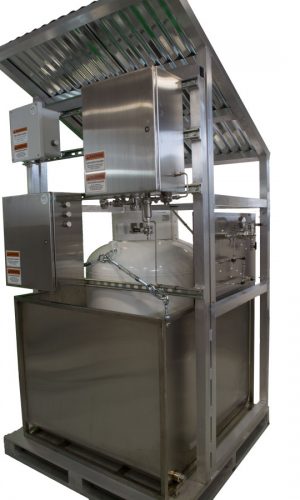Pipe Pickling (or pipeline conditioning and pre-odorization) is a process of conditioning new gas pipes before starting and commissioning a pipeline.
 Why do we pickle pipe?
Why do we pickle pipe?
Without pickling, it is common to experience odor fade in new polyethylene gas lines or have the natural gas odorant scrubbed/removed from the gas stream, making it odorless, a significant safety hazard.
Adsorption Issue and Odor Fade

While the GPL 750 Odorizer is a permanent turnkey system, it can also be a pickling unit because it is on a portable skid.
In a new pipe, odorant molecules attach to the pipe wall. Therefore, the odorant no longer remains in the gas stream, and it becomes odorless. The pipeline continues to adsorb the odorant until the line becomes saturated, then the odorant begins to stay in the gas. However, it is unclear how long this process can take, so it is common to “pickle” the line to speed up the progression.
In addition to the adsorption issue, a new steel pipe’s porous inner wall contains mill scale and rust, including metal oxides. The metal oxides react with some odorant (tert-butyl mercaptan) and create disulfides, which are less odorous than mercaptan. In this case, odor fade occurs.
What is Pipe Pickling?
Pickling is the process used on new gas lines to pre-odorize or saturates the line with odorant so that the pipe stops adsorbing the odorant. The line may be dosed initially with the extra odorant, perhaps by using a temporary odorizer. The odorant is monitored for detection on the back end of the pipeline. The pickling usually continues until the gas odorant level at the tail end of the line is comparable to the beginning or at the odorizer
3 Pickling Gas Pipe Methods
There are three main methods of pickling gas pipe:
- Injection of highly odorized gas (>40 PPM)
- Slugging*
- Continuous injection of a controlled dosage of liquid odorant through the pipeline
*When slugging, a liquid odorant is poured directly into the pipe and permitted to pickle for an extended period without flow.
Many parameters will impact the speed of pre-odorizing gas lines, including pipe material, the length and diameter of the pipeline, flow rate, and odorant. Of course, the target is to comply with regulations and have the gas on both ends of the line be detectable by a person with a “normal” sense of smell at 1/5th the lower explosive limit, and the LEL of natural gas is 5%. Therefore, the gas must be detectable when present at a 1% concentration in the air.
Perhaps you are interested in a gas pipeline pickling contractor or are you in the market for a temporary odorant injection system. Please let us know how we can help you!
If you are interested in a case study on pickling, visit “Pre-Odorization or “Pickling” of New Natural Gas Pipe.”


Thanks for this insightful read! I am not very well familiar with gas pipeline installations which is why I find posts like these very helpful.